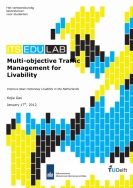The explosively increased traffic flow on the motorways is causing severe impact on ambient air quality and the health of those people exposed to it. Numerous diseases, such as respiratory diseases, lung diseases, and cancer, are associated with air pollutants. This is defined as the near-motorway livability problem, which seems quite serious in The Netherlands. Thus, the road authority is looking to improve air quality alongside the motorways, without compromising the current traffic efficiency. The research described in this report is therefore to find a balanced solution to improve near-motorway livability conditions. Two research methodologies are used: a literature review and a theoretical case study using simulation.
Numerous strategies exist to reduce traffic emissions, and it is difficult to judge which one is better than the others. As a short term option, dynamic traffic management (DTM) is usually preferred in practice. Therefore, several DTM measures that may reduce traffic emissions have been studied, and the strategy called Mainstream Traffic Flow Control (MTFC) is adopted in this study. The MTFC strategy can be applied to relocate the congestion and emissions on the motorway sections near to residential areas to an upstream section which is more environmentally insensitive. What is more, MTFC will not limit the traffic flows from the on-ramps, thus it avoids increasing traffic emissions on the on-ramps, which are normally close to environmentally sensitive areas. An MTFC strategy utilizing a combination of fixed/dynamic speed limits is used in this study, and a feedback ALINEA-like controller has been developed. A theoretical case study using VISSIM and MATLAB to simulate the impacts of the proposed controller on a hypothetical motorway network has been performed. The simulation result is promising in reducing the traffic emissions near residential areas by 13.30% and traffic delay by 6.58%.
The multi-objective optimization of the controller is performed by optimizing a generalized indicator of equally weighed traffic efficiency and traffic emissions reduction. In addition, the side-effects of the proposed controller have been studied. The traffic emissions on the motorway upstream of the target area are found to be increased. In the upstream section, a higher crash rate is found, but the traffic safety conditions on the target section are expected to be enhanced. Apart from this, the study on driver acceptance showed that MTFC may be opposed by a few drivers, who confront the relocated congestion but do not benefit from the improved traffic flow on the target section.
Further studies could be focused on the aspects given below: (1) Integrated network management following the four main principles of improving near-motorway livability using DTM measures; (2) take the impacts of MTFC on off-ramps into account; (3) demand management on the future induced traffic flow from on-ramps; (4) improve traffic safety in the dynamic speed limits affected section; and (5) involve a more functional traffic emission model.
